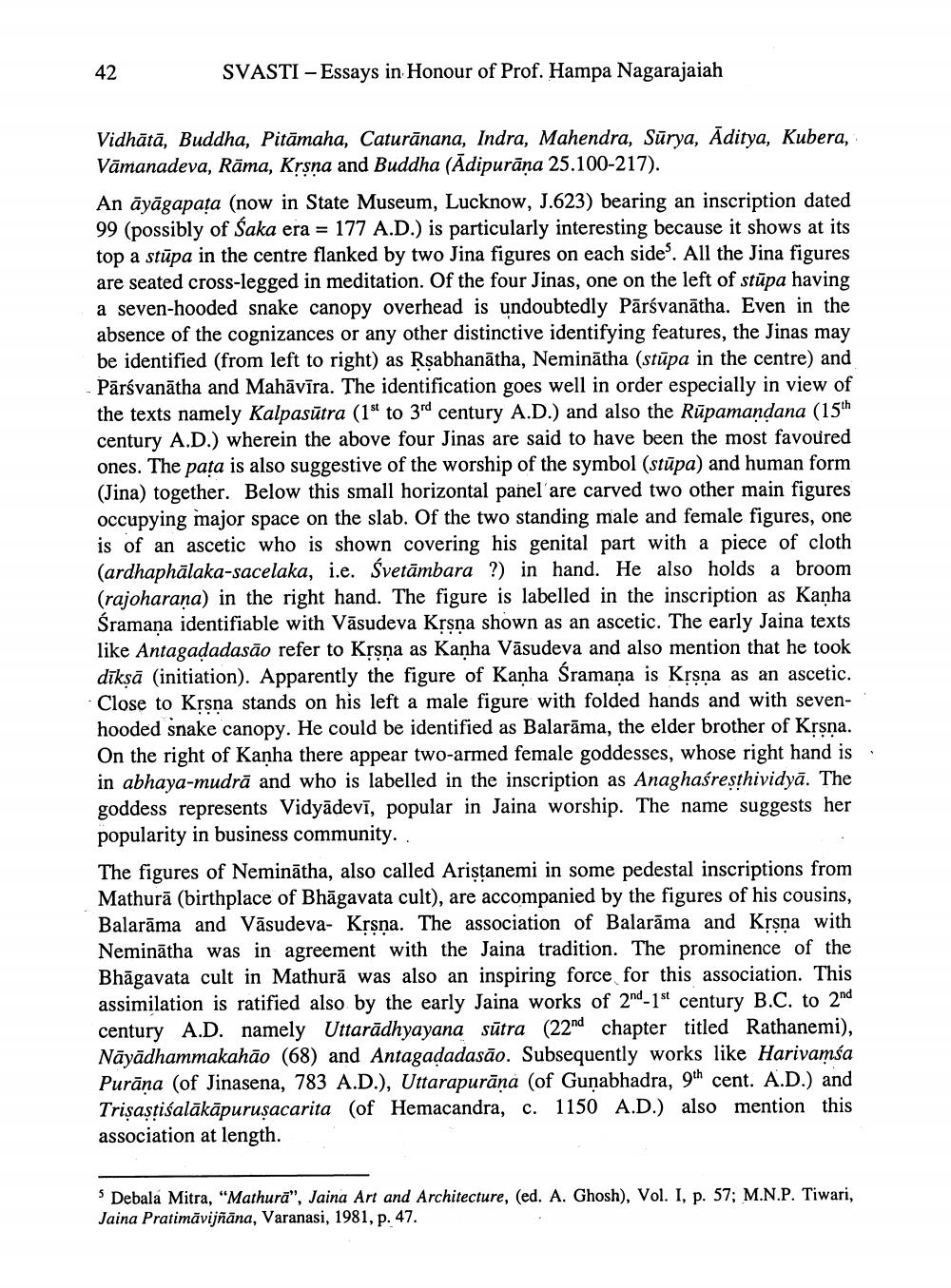________________
42
SVASTI - Essays in Honour of Prof. Hampa Nagarajaiah
Vidhātā, Buddha, Pitämaha, Caturänana, Indra, Mahendra, Sürya, Aditya, Kubera, Vāmanadeva, Räma, Kṛṣṇa and Buddha (Adipurāṇa 25.100-217).
An ayagapata (now in State Museum, Lucknow, J.623) bearing an inscription dated 99 (possibly of Saka era 177 A.D.) is particularly interesting because it shows at its top a stupa in the centre flanked by two Jina figures on each side". All the Jina figures are seated cross-legged in meditation. Of the four Jinas, one on the left of stupa having a seven-hooded snake canopy overhead is undoubtedly Pärśvanätha. Even in the absence of the cognizances or any other distinctive identifying features, the Jinas may be identified (from left to right) as Rṣabhanätha, Neminatha (stupa in the centre) and Pārsvanatha and Mahāvīra. The identification goes well in order especially in view of the texts namely Kalpasūtra (1" to 3rd century A.D.) and also the Rūpamandana (15 century A.D.) wherein the above four Jinas are said to have been the most favoured ones. The pata is also suggestive of the worship of the symbol (stupa) and human form (Jina) together. Below this small horizontal panel are carved two other main figures occupying major space on the slab. Of the two standing male and female figures, one is of an ascetic who is shown covering his genital part with a piece of cloth (ardhaphalaka-sacelaka, i.e. Svetambara ?) in hand. He also holds a broom (rajoharana) in the right hand. The figure is labelled in the inscription as Kanha Śramana identifiable with Väsudeva Kṛṣṇa shown as an ascetic. The early Jaina texts like Antagadadasão refer to Kṛṣṇa as Kanha Vasudeva and also mention that he took dīkṣā (initiation). Apparently the figure of Kanha Śramana is Krsna as an ascetic. Close to Krsna stands on his left a male figure with folded hands and with sevenhooded snake canopy. He could be identified as Balarama, the elder brother of Krsna. On the right of Kanha there appear two-armed female goddesses, whose right hand is in abhaya-mudra and who is labelled in the inscription as Anaghaśreṣthividya. The goddess represents Vidyādevī, popular in Jaina worship. The name suggests her popularity in business community..
The figures of Neminätha, also called Arişțanemi in some pedestal inscriptions from Mathura (birthplace of Bhagavata cult), are accompanied by the figures of his cousins, Balarama and Väsudeva- Kṛṣṇa. The association of Balarama and Kṛṣṇa with Neminatha was in agreement with the Jaina tradition. The prominence of the Bhagavata cult in Mathura was also an inspiring force for this association. This assimilation is ratified also by the early Jaina works of 2"-1" century B.C. to 2nd century A.D. namely Uttaradhyayana sütra (22nd chapter titled Rathanemi), Näyädhammakahão (68) and Antagadadasão. Subsequently works like Harivamsa Purana (of Jinasena, 783 A.D.), Uttarapuräna (of Gunabhadra, 9th cent. A.D.) and Trişaştisalakäpuruṣacarita (of Hemacandra, c. 1150 A.D.) also mention this association at length.
5 Debala Mitra, "Mathura", Jaina Art and Architecture, (ed. A. Ghosh), Vol. I, p. 57; M.N.P. Tiwari, Jaina Pratimavijñāna, Varanasi, 1981, p. 47.




